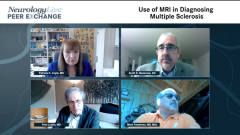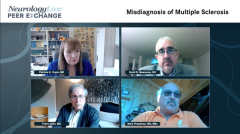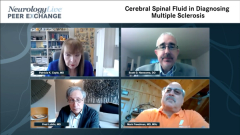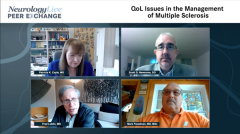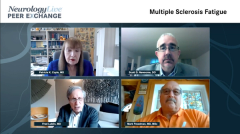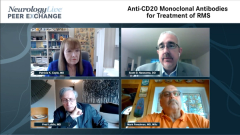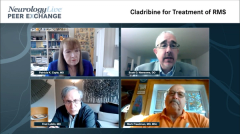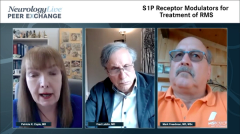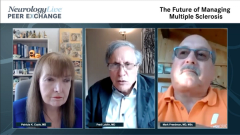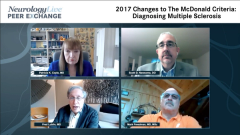
OPTIMUM Phase 3 Trial: Secondary End Point Effect on Fatigue
Episodes in this series

Mark Freedman, MD, MSc, discusses the secondary end point of fatigue-related symptoms assessed by the Fatigue Symptom and Impact Questionnaire–Relapsing Multiple Sclerosis (FSIS-RMS), a new MS-specific, 20-item patient-reported outcome measure. Scores suggested statistically significant effects on fatigue symptoms with ponesimod in comparison to teriflunomide.
Fred Lublin, MD: While we have you, Mark, let’s talk about the OPTIMUM study. That’s unique as it relates to fatigue.
Mark Freedman, MD, MSc: When that study was put together—I’m on the steering committee, so I take the Fifth here—we knew we were going to be in an era of competing S1P receptor agonists. How do we come above all the other drugs? What element could we use to show that there’s some added benefit to this particular S1P receptor agonist? Is there anything we can show that no one else has done? More and more, we’re hearing that patient-related outcomes are important. The differences that we’re seeing, even in relapse rates, are so small that they’re amounting to 1 or 2 attack differences over the years for patients. What is the true meaning of that, especially in a comparative study in which you’re not able to show an effect on disability? You’re dealing with 2 active agents and time periods that are too short to demonstrate that. We know that the outcomes are going to be measured by MRI and relapse rate. Is there anything else that can feed into that?
The thought was, let’s go after an important patient-related outcome that is undertreated and for which there is a huge unmet need. Since we’ve been talking about fatigue, that was the outcome that was chosen. It’s probably the No. 1 reason, or close to the No. 1 reason, patients are dropping out of gainful employment. They’re not able to meet the needs of their lives, not only at work but at home. It’s a huge dent in quality of life.
Kudos to the group. They took a big chance, as you know, in the OPTIMUM study. That study compared ponesimod and teriflunomide. They looked at the usual primary outcome measure of relapse rate. But when they came to the secondary outcome measures, which are often MRI and EDSS [Expanded Disability Status Scale], they instead looked at fatigue in a hierarchical analysis. That was the first secondary end point. Had they not hit a superiority threshold in that measure, they wouldn’t have been able to look at any of the other secondary outcomes. It was very risky in that sense.
They developed and used a fatigue impact questionnaire under the guidelines of the FDA to establish what is a good PRO [patient-reported outcome]. Using that, they were able to show superiority over the teriflunomide comparator, which is of interest because both drugs did control relapse rates. The S1P agonist was better than teriflunomide in that particular study, but we started to see an effect on fatigue that got better and better. It wasn’t a transient effect from starting the drug. It improved as the trial went on. Maybe this particular drug is impacting the primary fatigue that Pat was talking about.
We’ve seen exploratory outcomes of all the other drugs that have been out there. Those suggested an effect on fatigue post hoc, but here’s 1 of the trials that looked at prospective and chose it as the first secondary outcome measure.
That’s a wrap on the study, but if you want to get into particulars, I’m happy to discuss those too, Fred.
Fred Lublin, MD: Scott, do you have thoughts about this?
Scott D. Newsome, DO: Yes. Fred, you mentioned the value of PROs. Moving forward, at least in the United States, the FDA is requiring PROs to be in clinical trials. We’re learning the value of PROs. It’s interesting. They took a big risk using that as a main secondary end point. Am I necessarily surprised by the results? I suspect that some of our other current therapies, if that approach were taken, would probably have hit as well. If you shut down a lot of inflammation within the CNS [central nervous system], that may translate into improving some of those invisible symptoms, as Pat had mentioned. That’s true of fatigue and, potentially, cognitive fogging. Whether that’s a secondary by-product or is getting at the primary fatigue, we still need more data to describe that.
I agree with Mark. It was a big risk to do that. They hit, which is great. Thinking about the mechanism of action of the medications, the S1P modulators obviously work on the CNS side. Maybe the drugs that work on the CNS side have a greater potential to affect primary fatigue in MS [multiple sclerosis].
It’s interesting. We’ll have to see with more studies whether that will be the case with other medications. We need to continue to look at PROs in clinical trials, because at least in my practice, there was that disconnect between what the patient was experiencing and what I was seeing. They have a lot of value.
Fred Lublin, MD: That’s the issue with all patient-reported outcomes. There can be a disconnect there, and it could confound what you’re trying to measure. Some of it is just the way you measure them, and some of it is not understanding what the role of the specific medication is.
Pat, what are your thoughts on this?
Patricia K. Coyle, MD: It was surprising to see the benefit of teriflunomide benefit on fatigue, to be candid. The data are the data, but we’ve had S1P receptor modulators, and no one has told me the fatigue got so much better in my patients. I haven’t seen it. They also used an FSIQ [Fatigue Symptoms and Impact Questionnaire], which people were not familiar with. I know it’s a validated PRO for fatigue, but it’s not a typical one. It’s quite interesting. I can’t argue with the data. It will be interesting to see if they get it in the label. I know they’re in front of the FDA right now.
I’d like to see some additional backup, because maybe it’s giving some insight. Remember that ponesimod is theoretically just S19 receptor 1, so it’s interesting.
Fred Lublin, MD: Any thoughts on the pathophysiologic mechanism?
Patricia K. Coyle, MD: Absolutely not. I am a doubting Thomas. Give me some more data.
Fred Lublin, MD: Mark?
Mark Freedman, MD, MSc: There is a bit of S1P receptor 5 in there, but that idea doesn’t have the good data that some of the other S1P agonists have on CNS penetrance. If you’re thinking of a CNS-penetrance type of phenomenon, then that may be harder to prove. There are a considerable amount of data that cytokine release can drive fatigue. Many of these drugs, and others, cut down on cytokine release. Overall, they lower it with time. I don’t know which 1, or compilation of several, is driving the fatigue.
Some of the data that will be looked in this and other studies concern the reduction in the overall cytokine levels and matching that to fatigue levels. That has been hard to do, as you know, because measuring cytokine levels over time is difficult. They’re all over the place most of the time, even in a normal person. It’s a real challenge to do that, but the theory behind it is that we know certain cytokines are driving fatigue. I know IL-1 is 1 of the first cytokines. That’s the endogenous pyrogen in the brain. It drives fever, so it’s not surprising that some of these other inflammatory cytokines have the ability to drift into the brain and impact that primary fatigue mechanism.
It’s not unique to MS. A lot of the autoimmune diseases, which also enhance cytokines, are associated with very severe fatigue.
Fred Lublin, MD: Yes, that’s true, especially for things like lupus.
Newsletter
Keep your finger on the pulse of neurology—subscribe to NeurologyLive for expert interviews, new data, and breakthrough treatment updates.

